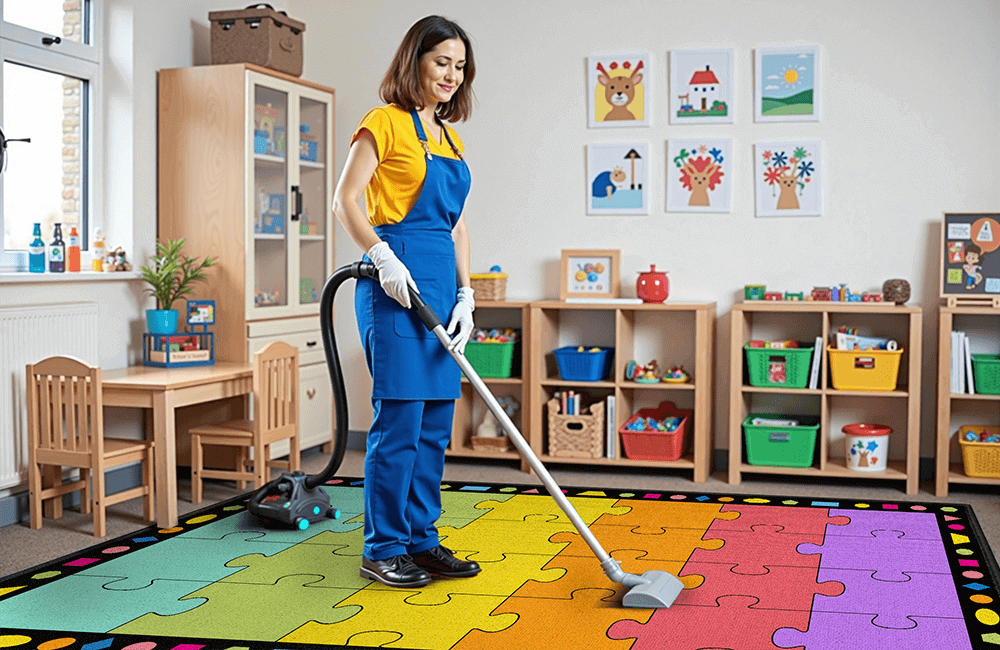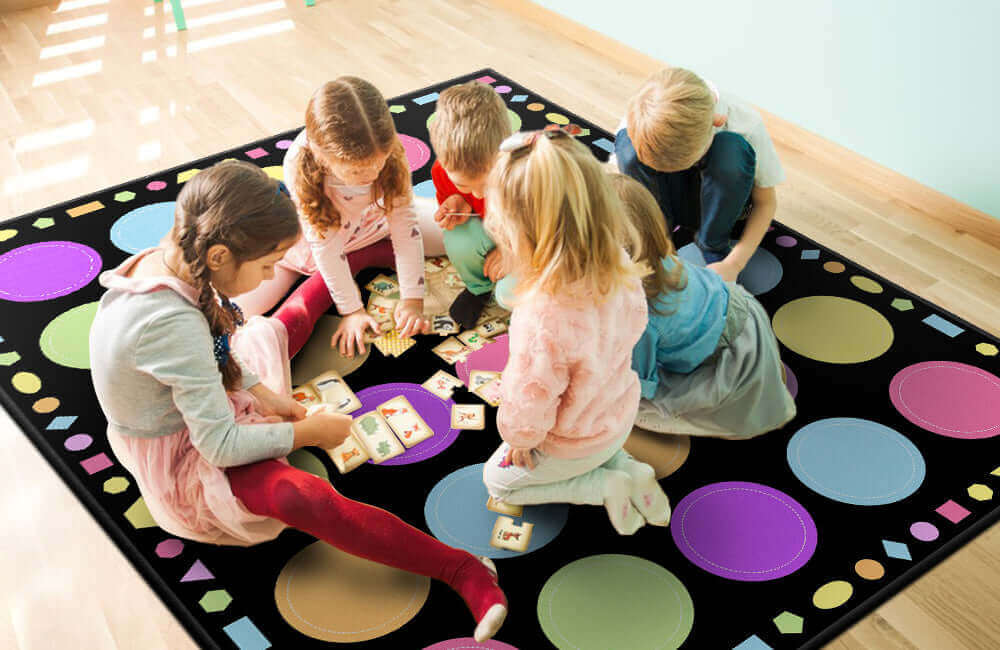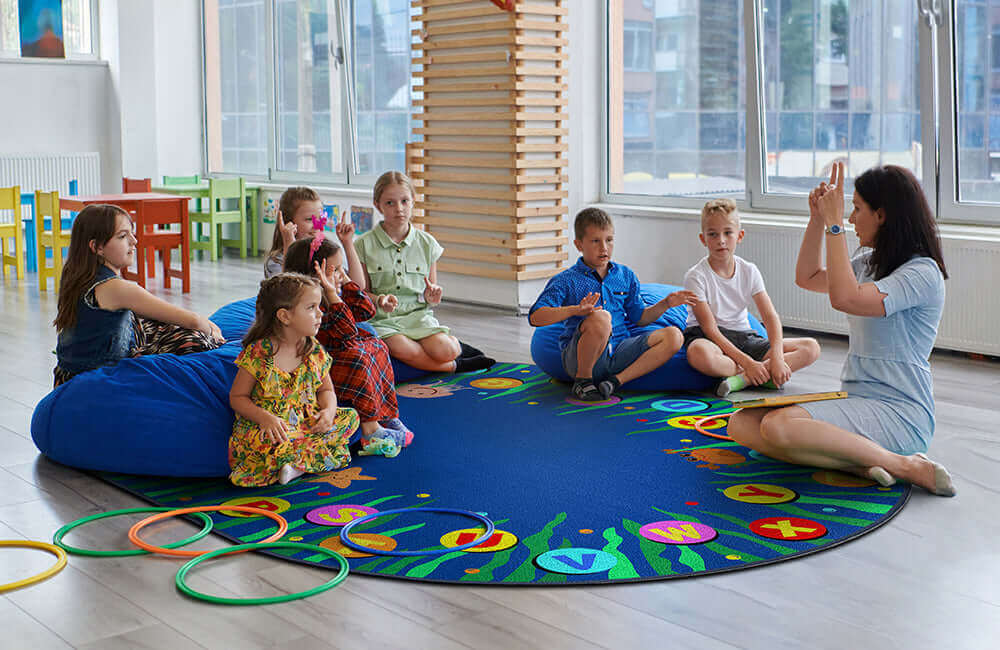In Montessori classrooms worldwide, the simple work rug serves as much more than floor covering—it represents a sophisticated educational tool embodying core Montessori principles of order, independence, and respect.
These carefully selected floor spaces define personal work areas, create visual boundaries for learning activities, and serve as tangible expressions of Montessori's profound respect for the child's work.
While many educational approaches utilize classroom rugs primarily for gathering or aesthetic purposes, the Montessori method elevates these defined spaces to essential components of the prepared environment.
Understanding this distinctive approach offers valuable insights for educators across various pedagogical frameworks seeking to create more intentional, child-centered learning environments.
The Philosophy Behind Defined Spaces
The Montessori approach to defined learning spaces stems directly from Dr. Maria Montessori's observations about children's developmental needs:
Order as a Developmental Need
Dr. Montessori identified order as a fundamental human tendency, particularly crucial during sensitive periods of development.
According to the American Montessori Society, "Children between the ages of two and four are in a sensitive period for order, craving consistency and predictability in their environment." Defined floor spaces provide:
- Clear physical boundaries that satisfy the need for order
- Consistent, predictable work protocols
- Visual cues that help children internalize classroom systems
- Concrete representations of abstract spatial concepts
Agency and Independence
Montessori's respect for the child's independence manifests through:
- Self-selected work spaces
- Child-maintained environments
- Physical boundaries that protect concentration
- Ownership of one's learning environment
Concentration and Deep Work
Montessori observed that children's development depends on their ability to concentrate deeply on self-chosen work—whether it's reading on a reading rug or solving puzzles in a focused zone.
Research published in Frontiers in Psychology confirms that clearly defined work spaces significantly enhance sustained attention in young children by:
- Reducing visual and physical distractionss—especially when using seating rugs for classrooms to separate learning zones
- Creating psychological boundaries around activities
- Supporting executive function development
- Increasing time-on-task measurements
The Work Rug Concept
At the heart of the Montessori approach to floor spaces is the "work rug" or "work mat"—a precisely defined area where a child conducts their chosen activity:
Function Over Decoration
Unlike decorative classroom carpets—such as pastel classroom rugs used in calming environments—Montessori work rugs prioritize:
- Neutral, solid colors that won't distract from materials
- Simple, defined edges without elaborate patterns
- Portability for child independence
- Standardized sizes for consistency and order
Physical and Psychological Boundaries
Work rugs serve dual boundary functions:
- Creating physical spaces that contain materials
- Establishing psychological zones that other children understand as private work areas
The Work Cycle Integration
Work rugs support the Montessori work cycle by:
- Marking the beginning of work (rolling out the rug)
- Supporting the middle phase (containing materials on the defined space)
- Signaling completion (rolling up the rug and returning it)
For more detailed information on the Montessori work cycle, visit our Montessori Foundations Guide.
Creating Order Through Floor Boundaries
The Montessori method utilizes defined floor spaces to reinforce concepts of order essential to cognitive development:
Material Organization
Work rugs help children:
- Distinguish between materials that belong to different activities
- Establish left-to-right and top-to-bottom organization
- Maintain material integrity during complex procedures
- Visually track multi-step processes
Spatial Awareness Development
Defined floor spaces enhance spatial awareness in various learning zones, whether it's a round classroom rug for circle time or a corner mat for reading :
- Body awareness in relation to objects
- Understanding of personal space versus communal space
- Development of spatial vocabulary (inside/outside, on/off)
- Mathematical concepts of area, perimeter, and dimension
Care of Environment
The work rug system teaches:
- Responsibility for one's materials and space
- Restoration of order as part of activity completion
- Systematic approaches to organization
- Respect for communal learning environments
Montessori education researcher Angeline Lillard notes that "The work mat creates a physical manifestation of the mental order children are developing, making abstract organizational concepts concrete and visible."
Movement and Freedom Within Limits
Montessori's emphasis on freedom within defined limits is perfectly exemplified through the floor space system:
Purposeful Movement
Work rugs encourage:
- Deliberate, mindful movement when carrying materials
- Control of body when navigating around others' spaces
- Physical coordination when rolling/unrolling rugs
- Spatial planning when selecting work locations
Social Boundaries
The defined spaces teach:
- Respect for others' concentration
- Non-verbal cues for engagement/non-disturbance
- Appropriate ways to observe others' work
- Permission-seeking protocols for collaborative activities
Freedom of Choice
Within the system, children experience freedom through:
- Choosing where to place their work rug
- Deciding which materials to bring to their space
- Determining how long to engage with an activity
- Selecting between individual or partner work
Our Movement in Learning guide explores additional connections between purposeful movement and cognitive development.
Practical Applications for Any Classroom
While authentic Montessori classrooms follow specific protocols, educators in various settings can adapt key principles:
Traditional Classroom Adaptations
Teachers in conventional classrooms can:
- Designate specific floor areas for different subjects or activities
- Use individual mats for reading or independent work
- Create portable "office spaces" with simple rugs
- Establish clear protocols for respecting defined work areas
Home Learning Environments
Parents can implement:
- Consistent work spaces defined by simple mats
- Clear boundaries between activity areas
- Storage systems that connect to specific work spaces
- Protocols that mirror classroom respect for work areas
Special Education Applications
Educators supporting diverse needs can utilize:
- Color-coded spaces for different types of activities
- Sensory-appropriate floor coverings for specific needs
- Visual boundary markers for students who benefit from explicit spatial cues
- Gradual introduction of shared space concepts
According to Edutopia's research on learning environments, "Clear physical boundaries significantly support executive function development, particularly for students with attention or sensory processing differences."
Material Selection and Considerations
The effectiveness of a work rug system depends largely on thoughtful material selection:
Traditional Montessori Specifications
Authentic Montessori environments typically feature:
- Natural fiber rugs (wool or cotton)
- Neutral, solid colors (often beige, off-white, or subdued tones)
- Uniform sizes appropriate to workspace needs
- Clean, bound edges without fringe or decoration
Practical Alternatives
More budget-conscious options include:
- Canvas placemats with bound edges
- Felt sheets cut to consistent dimensions
- Yoga mats trimmed to appropriate sizes
- Fabric remnants with finished edges
Sensory Considerations
Consider varying textures based on:
- Age group sensory preferences
- Activities typically conducted on the spaces
- Acoustical needs of the environment
- Maintenance requirements in your setting
Visit our Classroom Materials Guide for specific product recommendations and comparisons.
Implementing a Work Rug System
Successfully introducing defined floor spaces requires intentional processes:
Demonstration and Modeling
Begin with:
- Clear, slow demonstrations of proper rug handling
- Explicit modeling of respect for others' spaces
- Specific language around work boundaries
- Grace and courtesy lessons related to shared spaces
Gradual Implementation
Consider a phased approach:
- Start with a limited number of rugs
- Initially designate specific activities for rug work
- Gradually increase availability as protocols become internalized
- Add complexity to the system as children demonstrate readiness
Consistent Maintenance
Sustain the system through:
- Regular cleaning routines (involving children when appropriate)
- Prompt replacement of damaged rugs
- Consistent reinforcement of protocols
- Periodic community discussions about space respect
The North American Montessori Teachers Association emphasizes that "Consistency in implementing spatial boundaries is essential to their effectiveness—occasional or inconsistent boundaries create confusion rather than order."
Beyond the Traditional: Modern Adaptations
Contemporary Montessori-inspired environments have evolved the work rug concept:
Technology Integration
Modern applications include:
- Defined spaces for digital learning tools
- Charging stations connected to specific work areas
- Color-coded zones for different technology purposes
- Digital photography of completed work before dismantling
Collaborative Adaptations
Today's emphasis on collaboration has introduced:
- Larger rugs designated for partner work
- Systems for joining individual spaces for group projects
- Visual cues—like color-coded zones using colorful classroom rugs indicating "open to collaboration" versus "individual work in progress"
- Protocols for respectful entry into others' work spaces
Environmental Sustainability
Contemporary considerations include:
- Eco-friendly, sustainable materials
- Washable, long-lasting natural fibers
- Local sourcing of materials when possible
- Repurposed or upcycled materials that maintain defined boundaries
Our Contemporary Montessori Resources section explores additional modern adaptations while maintaining core principles.
Conclusion
The Montessori approach to defined floor spaces represents a sophisticated understanding of children's developmental needs for order, independence, and concentration.
Far beyond simple classroom decoration, these purposeful work areas embody core Montessori principles and provide concrete manifestations of abstract concepts like respect, boundaries, and order.
Whether implementing a full Montessori work rug system or adapting key principles for conventional classrooms, the thoughtful use of defined floor spaces offers significant benefits for children's cognitive, social, and executive function development.
The beauty of this approach lies in its simplicity—with minimal financial investment but thoughtful implementation, educators can create physical environments that profoundly support children's natural development.
As Dr. Montessori observed, "The first essential for the child's development is concentration.
The child who concentrates is immensely happy." The humble work rug, properly implemented, creates the conditions for this essential concentration and the deep learning that follows.




Leave a comment
This site is protected by hCaptcha and the hCaptcha Privacy Policy and Terms of Service apply.